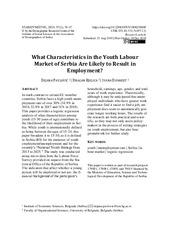Please use this identifier to cite or link to this item:
https://rfos.fon.bg.ac.rs/handle/123456789/2020Full metadata record
| DC Field | Value | Language |
|---|---|---|
| dc.creator | Pavlović, Dejana | |
| dc.creator | Bjelica, Dragan | |
| dc.creator | Domazet, Ivana | |
| dc.date.accessioned | 2023-05-12T11:25:53Z | - |
| dc.date.available | 2023-05-12T11:25:53Z | - |
| dc.date.issued | 2019 | |
| dc.identifier.issn | 2217-3986 | |
| dc.identifier.issn | 0038-982X | |
| dc.identifier.uri | https://rfos.fon.bg.ac.rs/handle/123456789/2020 | - |
| dc.description.abstract | In stark contrast to certain EU member countries, Serbia faces a high youth unemployment rate of over 30% (34.9% in 2016, 32.8% in 2017 and 31% in 2018). This paper provides a logistic regression analysis of what characteristics among youth (15-30 years of age) contribute to the likelihood of their employment in Serbia. While youth is internationally defined as being between the ages of 15-24, this paper broadens it to 15-30, as it is defined in Serbia (RS) for the purposes of youth employment/unemployment and for the country’s “National Youth Strategy from 2015 to 2025.” The study was conducted using micro data from the Labour Force Survey provided on request from the Statistical Office of the Republic of Serbia. The indicators that affect whether a young person will be employed or not are: the financial background of the participant’s household, earnings, age, gender, and total years of work experience. Theoretically, although it may be anticipated that unemployed individuals who have greater work experience find it easier to find a job, employment does seem to automatically generate longer working hours. The results of the research are both practical and scientific, as they may not only assist policymakers in the process of writing strategies on youth employment, but also bear groundwork for further study. | en |
| dc.publisher | Demographic Research Centre | |
| dc.relation | info:eu-repo/grantAgreement/MESTD/Basic Research (BR or ON)/179001/RS// | |
| dc.relation | info:eu-repo/grantAgreement/MESTD/Basic Research (BR or ON)/179081/RS// | |
| dc.relation | info:eu-repo/grantAgreement/MESTD/Integrated and Interdisciplinary Research (IIR or III)/47009/RS// | |
| dc.relation | info:eu-repo/grantAgreement/MESTD/Basic Research (BR or ON)/179015/RS// | |
| dc.rights | openAccess | |
| dc.rights.uri | https://creativecommons.org/licenses/by/4.0/ | |
| dc.source | Stanovnistvo | |
| dc.subject | Youth | en |
| dc.subject | Unemployment rate | en |
| dc.subject | Serbia | en |
| dc.subject | Logistic regression | en |
| dc.subject | Labour market | en |
| dc.title | Koje karakteristike tržišta rada mladih doprinose zapošljavanju u Srbiji? | sr |
| dc.title | What characteristics in the youth labour market of Serbia are likely to result in employment? | en |
| dc.type | article | |
| dc.rights.license | BY | |
| dc.citation.epage | 47 | |
| dc.citation.issue | 2 | |
| dc.citation.other | 57(2): 35-47 | |
| dc.citation.spage | 35 | |
| dc.citation.volume | 57 | |
| dc.identifier.doi | 10.2298/stnv190823006p | |
| dc.identifier.fulltext | http://prototype2.rcub.bg.ac.rs/bitstream/id/626/2016.pdf | |
| dc.identifier.rcub | conv_3618 | |
| dc.identifier.scopus | 2-s2.0-85085657330 | |
| dc.type.version | publishedVersion | |
| item.cerifentitytype | Publications | - |
| item.fulltext | With Fulltext | - |
| item.grantfulltext | open | - |
| item.openairetype | article | - |
| item.openairecristype | http://purl.org/coar/resource_type/c_18cf | - |
| Appears in Collections: | Radovi istraživača / Researchers’ publications | |
This item is licensed under a Creative Commons License


